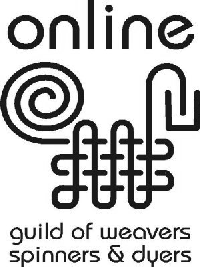3D Tapestry
March 2021.
Tapestry weaving is an historic technique used for centuries to create flat wall and floor coverings.
Contemporary tapestry art not only embraces the traditional approaches but increasingly pushes the boundaries through
the creation of 3-dimensional works. Through the Spring of 2021 the Online Guild enjoyed a workshop, led by tapestry artist,
Heather Seddon, which explored the techniques involved in created these 3-dimensional effects. Heather encouraged those
taking part to pull warps, twist them, add extra warps, create tunnels, weave around solid shapes and use natural
objects as weaving frames – with some remarkably interesting outcomes!
Carol Hunter, who lives in the Rocky Mountains, Canada, had a go at all the techniques including adding supplementary warps. She found keeping the supplementary sections tensioned evenly and keeping the selvedges on them straight was a challenge but for the most part things improved the more supplementary sections she wove. She also took advantage of the opportunity to try some different finishing techniques on the supplementary sections.
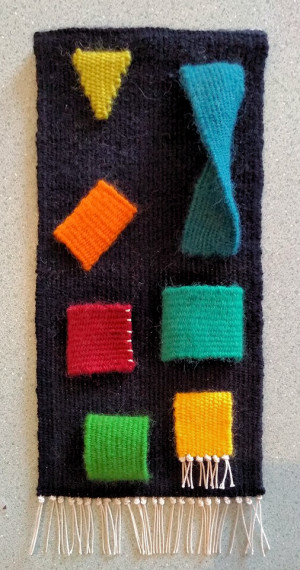
Carol Hunter's supplementary warp sample.
In Oxfordshire, Matty Smith focused on the pulled warp techniques.
This involved leaving unwoven triangular sections and then pulling the warps in those sections until the woven areas met,
resulting in a distorted fabric. Her first attempt, using green yarns, was a bit ‘lumpy’,
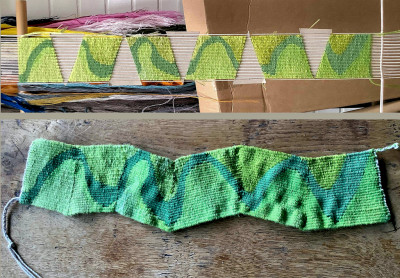
but the second one, which was monochromatic, was much more successful.

Many of those taking part enjoyed making ‘tunnels’, which involved leaving sections of warp unwoven and then pulling the warps through causing the tapestry fabric to ‘bunch up’. Alison Fretwell, who lives in Nottinghamshire, was pleased with her woven tunnels (not a phrase she ever expected to say!).
She used them to create a holder for a bobbin.
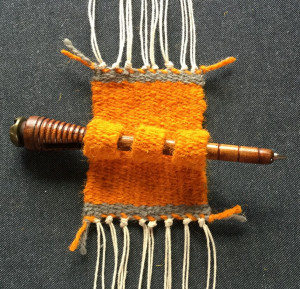
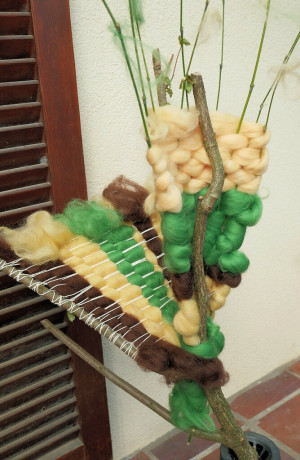
Juliana G, who lives in France, found a branch and some bamboo sticks and used these to create a weaving frame. This was something she had always wanted to do and the result is very impressive.
Other objects used as weaving frames included tin cans, bottles and boxes. In SW Scotland, Rita Corbett found a glass jam jar and wove around it creating a very stylish paint brush holder. She says “I pulled some of the warps and used others as part of the design. The bow knots to pull the piece together and to fix it to the jar have been chosen by my friend for whom the jar is a present.” What a lovely gift!
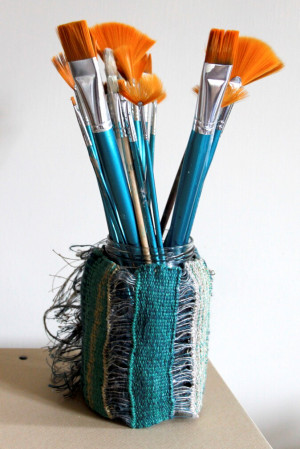
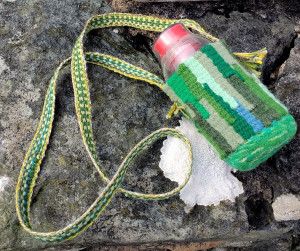
Sarah Cage, based in Birmingham, combined three techniques in her 3D tapestry woven bottle carrier. The base was made using a machine-sewn coiled pot technique with an inkle woven carrying strap and a tapestry woven body. The result is a sturdy but distinctive and very colourful bottle carrier.
This six-week workshop gave those taking part plenty of time to get to grips with the techniques Heather so carefully outlined in her supporting documentation and comments. The results certainly illustrate how flexible tapestry weaving can be and introduces great opportunities to expand the traditional perception of it. As Carol Hunter said “One of the best things about the classes is seeing the different effects people get without having to weave them all ourselves and seeing things done in a way I wouldn't have thought of trying.”
